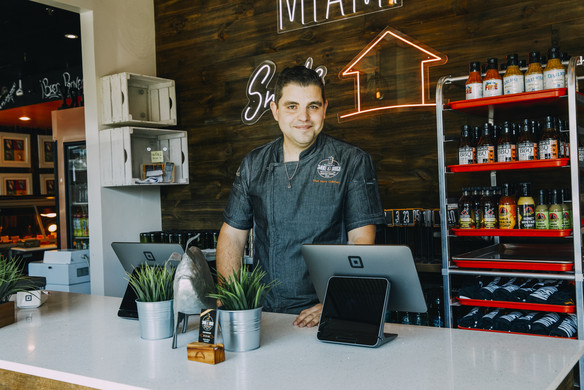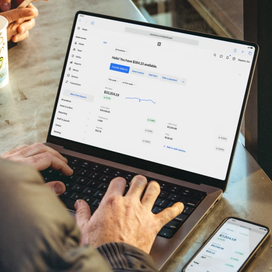Table of contents
Considering expanding your business to a second location but unsure where to start? There are plenty of reasons successful small business owners look into additional locations, whether that’s increased revenue opportunities, trying out a new concept, venturing into a different area with high demand, or giving loyal staff members a chance to stretch their abilities.
Miami bakery Empanada Harry’s and Pasadena’s Good Luck Wine Shop recently opened second businesses — barbecue restaurant Smoke & Dough for the Harry’s crew, and liquor store/community grocery Altadena Beverage & Market for the Good Luck owners.
Here are their cost-effective tips for planning, staffing, soft opening, and marketing a second business.
1. Start with a clear plan and goals.
A pandemic pivot inspired Michelle and Harry Coleman’s barbecue restaurant. The couple was looking for additional revenue at their empanada shop, so Harry began smoking meat using the same blend of modern Miami flavors that became a staple with their empanadas. Harry loved the work and customers flocked to the new offering, sparking the idea of a new concept that mirrored the vision of Empanada Harry’s.
The Good Luck owners embraced an opportunity when the original Altadena Beverage store — only a few miles from their Pasadena wine shop — was put up for sale. Taking over an existing market gave the team a chance to try something new that the community was looking for.
The businesses didn’t expanded for the sake of expanding. Going in with an understanding of customer demand (aided by insights from tools such as Square Dashboard), the ability to deliver a high-quality product, and a grasp of the personal and professional expectations of the additional work helped set them up for success.
“I feel like sometimes, if you’re not careful, you expand with this idea of growth and then you realize your quality is not the same and then you’re just another franchise,” Michelle said. “We’re very passionate people and that’s not something that we could ever live with.
2. Consider staffing for both locations early on.
One reason the Good Luck owners were able to invest so much of their time in opening the new version of Altadena Beverage was that they had hired a manager for the wine shop who could handle day-to-day operations. The new location opened up opportunities to try something new while also giving current employees a chance to take on larger responsibilities
The Coleman’s needed nine new staff members for Smoke & Dough, and they were helped by their reputation for taking care of employees — no one was laid off from Empanada Harry’s during the pandemic — paying people well, and promoting an environment of creativity.
“What we’re putting out there is something you can’t find anywhere and we’re super open about having different smoked items of the month, different plates,” Michelle said. “We like for people to give opinions. So that, for a chef, I think, is really important for them to feel like they’re in an environment where their opinions matter.”
3. Look for creative ways to cut costs.
The Colemans had to invest in building out their kitchen for Smoke & Dough, but it’s still the same shared kitchen with Empanada Harry’s. That lowered their overhead and also simplified the expansion process.
“I’m in both of my kitchens at the same time. And there’s no price on that, the value is too great,” Harry said.
Without the shared kitchen, a second location might not have seemed feasible. Day-to-day operations are also easier and more cost efficient for the owners with their KDS, team management tools, and dashboard analytics all synced with Square. They can run payroll and manage staff schedules across both businesses in one place.
For the Altadena Beverage owners, taking over an existing liquor store rather than starting from scratch also made the leap to a second location less daunting. While they invested in a new paint job, having a place with solid bones and infrastructure, such as refrigeration, streamlined the process. From one of the shop’s Instagram posts featuring before and after photos: “One of my favorite things about this market is how great the bones are. Not much was changed to reopen. Adding paint is easy. The history and community are built in. That’s the best.”
4. Try a slow rollout, be transparent, and seek feedback.
The Altadena Beverage owners planned for the full version of their store to feature a coffee bar, prepared food, and local produce. But in late January the store was in good enough shape to have a soft opening, at least selling liquor and some retail food items, so they decided to launch with what they had.
This helped the business start generating revenue sooner, as rent costs were coming in. It also provided additional marketing and customer feedback opportunities. For every new item added to the shop — CSA boxes, coffee, to-go sandwiches — Altadena Beverage could build excitement through social media and gauge interest.
5. Consider partnerships.
Altadena Beverage was able to expand the market’s offerings by partnering with local businesses, including a nearby coffee roaster and bakery with pop-up availability at the store — another cost- and time-saving measure.
6. Prioritize quality and balance.
The owners of Empanada Harry’s and Good Luck Wine knew that customers valued both the high quality of their products as well as their reliable customer service. Expanding wouldn’t have been an option if it meant sacrificing either one, even if there was potential for some additional revenue early on.
“We’re happy here,” Michelle said. “Another issue, as far as expansion goes, is that if there was ever a time where an opportunity came to expand, our biggest thing is, is that quality cannot be sacrificed.”
Investing in local second locations with a relatively streamlined startup process also has helped maintain room to focus on the family time they value.
“This is nice, at least for now,” Michelle said. “Our kids are 10 and seven, so we need to also have some room for family time, and the best way to do it is if we’re in one place.”
![]()











